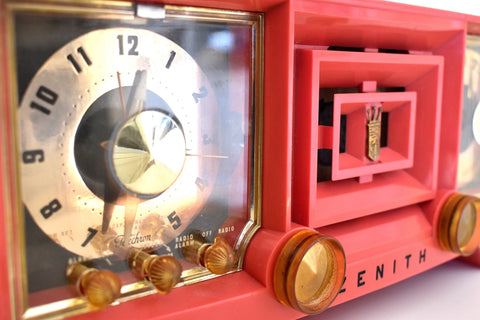Owl Eyes - The Wise Look of Mid Century Zeniths

"Owl Eyes" is an affectionate term to describe radios that have this look. Side-by-side clock and tuning with the speaker in the middle gives the appearance of the face of an owl. Even though other manufacturers have models that also have this look, Zenith's G, J, K, L, M, and R-series from the early to mid-fifties are most often described with "Owl Eyes."
G516 Owl Eyes
Zenith's G516 is an early "Owl Eyes" made between 1950-51 and available in brown molded Bakelite (B) and white (W). It was a Bakelite cabinet with two large symmetrical round dials.

Racetrack Owl Eyes
Here's a Marzipan Ivory and Tortoiseshell 1954 Zenith Model M510W also available in burgundy (M510R) and grey (531G). This model has an early 50s H-series racetrack Consol-Tone profile but with two round volume and tuning dials that make this unmistakably owl-ish.

Beak Owl Eyes
The Zenith 514, 515, 518, and 616 models have a more streamlined stance with a gradual beak contoured face. Zenith used a letter and number convention for these 1952 through 1954 models. A prefix J and K meant it was made in 1952. L was made in approximately 1953. And M was made in approximately 1954. A suffix letter was to signify colors for green (F), ivory (W), grey (G) or the rare pink (V).

Square Owl Eyes
A square looking Owl Eyes was available beginning in 1955 with model series R521 available in burgundy (R), green (F), black (Y), gray (G), white (W), and pink (V). The R519 had a louvered grill versus grid shaped grill.
Here's a 1955 shamrock green R521F with gold grid patterned grill. Like birds of different feathers, these sometimes had contrasting colored grills, black with red grill, green with gold, gray with white, or gray with gold grill for example.

Here's a 1955 R519V with louvered looking grill in a rare pink:

Bulging Owl Eyes
Here's K622 and L622 (1953), the bulging Owl Eyes, available in molded all brown Bakelite, brown and gold grill, painted all green (L), green and gold grill, painted all white (W), white and gold grill, black (F), black and red grill, grey (G), grey with white grill.



Here's an A515 in rare lime green color with white grill. This particular example has a rare basic Telechron clock movement with only wake to radio alarm function no buzzer. No sleep timer. No tuning or clock light.

Sitting Owl Eyes
Near the last of the Zenith Owl Eyes is the 1956 Z series, the sitting Owl Eyes. Molded in plastic grey (G), black (Y), burgundy (R), and white (W)

The Zeniths from this period are good performers. Most of these were 5 tubes circuits. Some were 6 tube circuits with even better broadcast range sensitivity and selectivity. Most all these Owl Eyes clock radios used Telechron movements with wake to buzzer and sleep timers. Almost all had an appliance timer in back. Speakers were 4" permanent magnet.
These Owl Eyes are hard to find without cracks on top. Even though the R511 "Broadway" model had a slightly thicker section on the back edge, these tops still developed hairline cracks beginning at the back edge. The Bakelite models were less likely to develop cracks on the top.
The back cardboard mounted antenna was a flimsy design with Zenith models throughout the early to mid fifties. The backing board was attached with 4 t-pins which pressed into holes in the cabinet back. The corners of the backing board get fatigued or rip. So on most surviving examples, the antenna backing board is barely hanging on or missing.
The other usual defects are missing clock knobs or broken brass clock function switch posts but that was common among all Telechron movements.
Internally, these mid-century Zenith birds were steel chassis and all point to point wiring. There were no circuit boards in any mid-fifties Zenith Owl Eyes. Alignment was tricky on Zeniths from this period. It is easy to shatter the ferrite tuning slug during alignment even with proper tools. Silver migration disease makes these angry birds difficult to repair and align. A difficult rebuild process than more prevalent Automatic IFT cans but doable.
